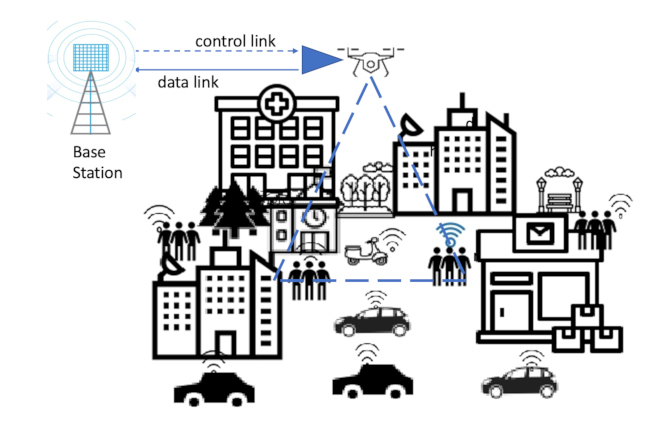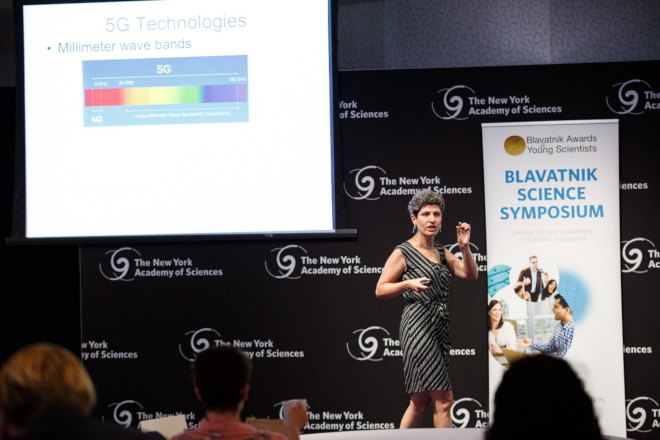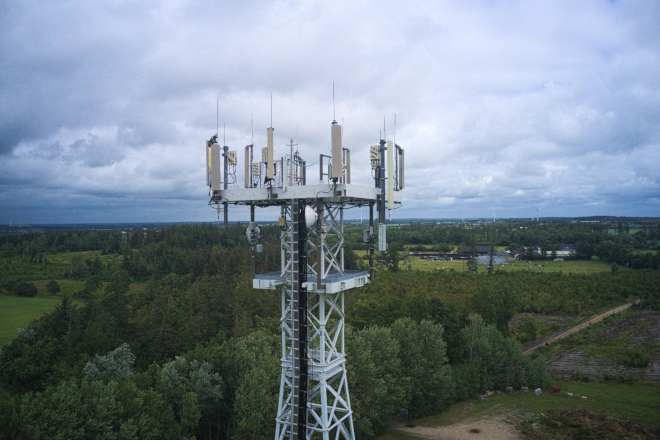
Credit: Francesco Linsalata - Own work, CC BY-SA 4.0, https://commons.wikimedia.org/w/index.php?curid=91519045
5G mobile technologies are being deployed at a rapid pace in major cities around the globe–from Shanghai (China) to New York City, and techies, worldwide, excitedly agree that 5G will not only transform the way we communicate, but will fundamentally alter the way the manufacturing industry runs its factory floors. To help us understand what all the excitement around 5G really means to the average mobile user, we asked Elza Erkip, PhD, Institute Professor of Electrical and Computer Engineering at New York University and a 2010 Blavatnik Regional Awards Faculty Finalist, to share her thoughts on the new 5G technology being developed here in the United States, her research, and the future of mobile communications. This interview has been condensed and edited for clarity.
What is 5G technology and what can 5G technology enable in our everyday lives?
Today, there are two technologies envisioned for 5G. In several parts of the world (such as Europe and China), a technology called “massive MIMO”, which is based on current 4G frequencies is being deployed. The United States favors a higher frequency version, known as the millimeter Wave (mmWave) technology. While the mm-wave technology provides faster communication, it requires new infrastructure and a denser deployment of base stations. Compared with today’s current technology, both flavors of 5G will give us a much higher speed of communication with lower delays. There are many applications that are envisioned, such as autonomous driving vehicles; low weight, low cost robotics; and augmented reality (AR), and up to now, all of the advances made in communications have been based on the notion that humans use devices. However, with 5G technology, an Internet of Things (IoT) is being envisioned—a network of sensors and devices that are able to interact with one another. These machine interactions could enable even more applications, including, sensing in a field, home monitoring systems, and a host of healthcare applications.

Prof. Elza Erkip speaking on 5G technologies at the 2019 Blavatnik Science Symposium held at the New York Academy of Sciences
How might 5G technologies and the Internet of Things (IoT) benefit industry?
Imagine a factory floor where airplanes are built by robots that work cooperatively with humans and also with one another to get any number of complex tasks done. Today, this does not happen in airplane manufacturing. For example, humans are needed inside the tight confines of a plane’s hull to perform any number of tasks, including tightening small screws. To fully automate airplane manufacturing, a robot would need to be light-weight and carry very little computational power, since computations require such bulky hardware. However with a 5G wireless communication link, information in the form of data could be pushed to the cloud for computation, very quickly, and returned back from the cloud to the robot as fast real-time feedback, so the robot is free to only sense its environment while lifting its arm inside a plane without the worry of accidentally damaging other airplane parts.
What role should engineers and researchers play in dispelling some of the myths and fears surrounding 5G?
There have been several studies looking at safety of high frequency 5G technology, and there is no scientific evidence showing 5G to be harmful to our health. Even though 5G researchers know this, we could do a better job of getting this information to the public. It is important for researchers to cite the proper scientific studies, and where possible, collaborate with doctors to further strengthen studies. I think this is an area where engineers could do better with public relations outreach to dispel myths.

Elza Erkip speaking with her NYU Faculty colleague and Blavatnik Awards Regional Judge Nasir Memon at the 2017 Blavatnik Science Symposium
Research in your lab is at the forefront of mobile technology. What specific questions are you addressing in your lab and how may it impact users of 5G technology?
My lab is looking at 5G technology from a variety of perspectives. 5G technologies are very energy-intensive, so we are looking into ways of lowering energy consumption while still maximizing the benefit that 5G can bring. We are also looking at privacy. When we surf the internet, we are constantly leaving digital “breadcrumbs” behind that reveal part of our identity. No matter how well-intentioned a website or app, digital breadcrumbs can be brought together to compromise a user’s privacy or identity. For wireless technology, privacy becomes even more important. Digital breadcrumbs can be collected by apps on our phone, including data from wireless carriers on our mobility patterns. So, keeping the exciting tools that these apps enable while maintaining the privacy of wireless users is quite a challenge, and is something my research group is seriously thinking about, as well.

5G Vodafone Mobile phone base stations in Germany
Credit: Fabian Horst / CC BY-SA (https://creativecommons.org/licenses/by-sa/4.0)
What interesting applications are being imagined for the future, beyond 5G technology?
Overall, the industry is looking to increase communication speeds even further, which might one day enable applications that currently sound like science fiction, such as 3D-hologram video conferencing. There is currently no real consensus on what a future 6G technology will bring, but there are some sophisticated ideas out there, like “edge computing,” which is a type of sharing of data-storage capabilities that could be optimized across a mobile network of systems and devices to further speed up communications. For example, if you’re streaming your favorite show, the next episode could be uploaded to servers located closer to you rather than remaining on the streaming service’s centralized servers. This would reduce demand on wireless networks. Other features being discussed for 6G are wireless power transfer technologies that can power a drone and use the exact same signal to also communicate with the drone. Sounds a bit like science fiction, but a lot of good theoretical work in the mobile communications space suggests that this technology is a real possibility. We're not there yet but the question in my mind is, “Can we make this a reality for 6G?”